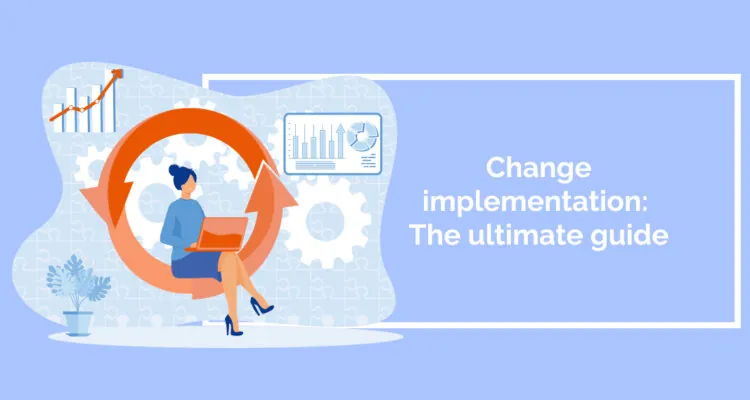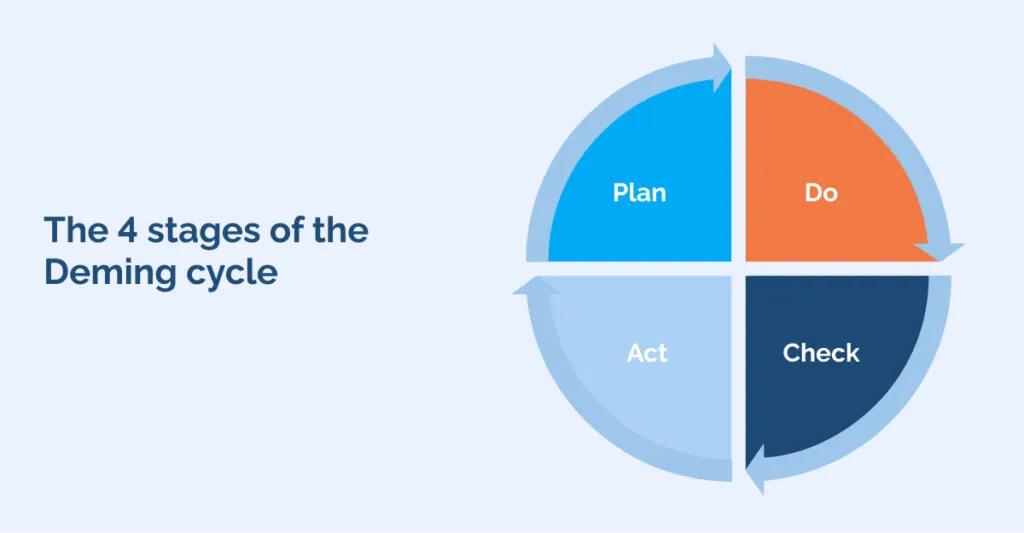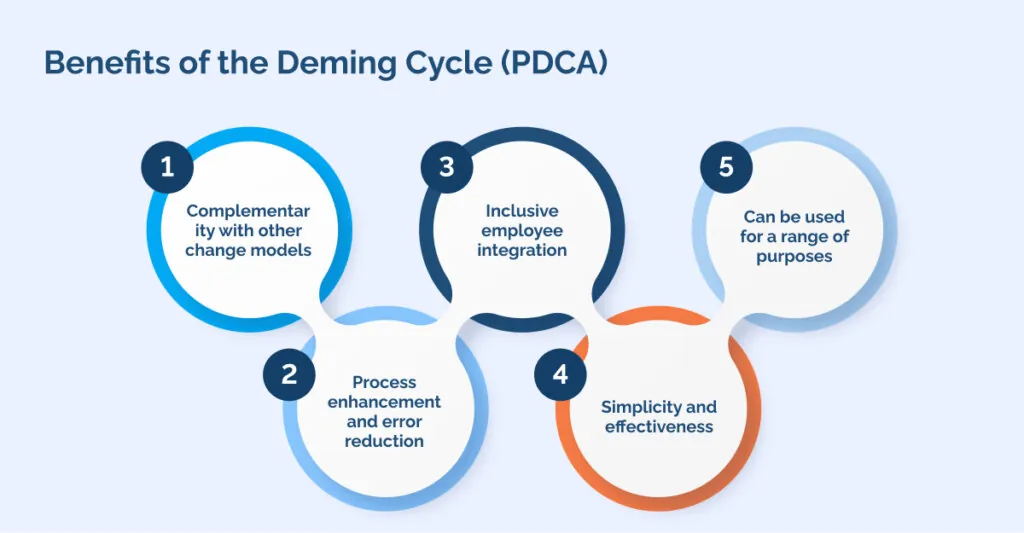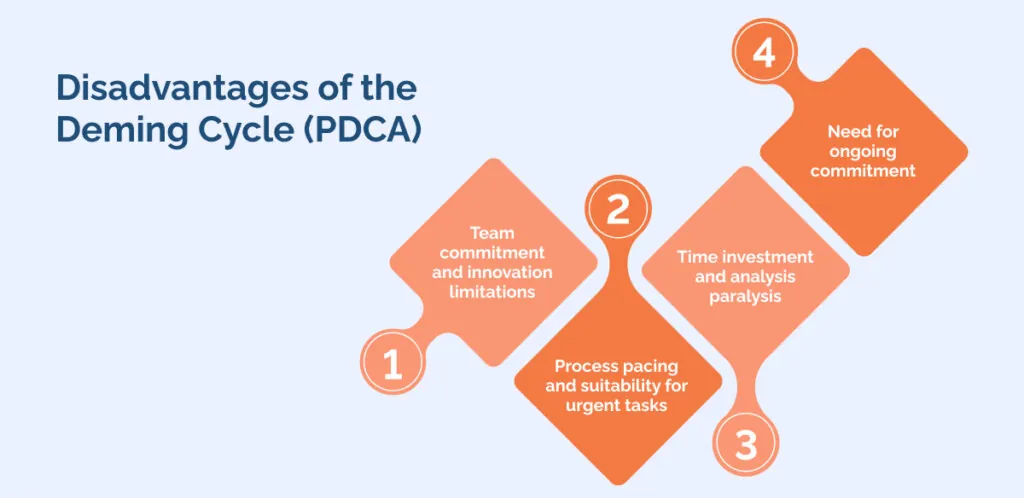
Creating an iterative employee feedback loop becomes increasingly vital as organizations grow and transform. These loops facilitate continual learning and adaptation, making them essential components for the successful implementation and sustainability of change.
This approach helps manage the complexities of transformational changes and ensures that the organization remains responsive and resilient despite evolving challenges and opportunities.
The Plan-Do-Check-Act (PDCA) cycle, created by Dr William Deming, allows organizations to implement an iterative four-step feedback loop to implement and successfully manage change.
Much like a circle with no end, the PDCA cycle is designed to be repeated continuously, embodying the principle of ongoing improvement central to lean thinking practices.
At the heart of the PDCA cycle is the concept of iteration, a core aspect of the scientific method. This iterative process involves testing a hypothesis and, based on the findings (whether the hypothesis is confirmed or disproven), executing the cycle again to expand and refine knowledge.
Each repetition of the PDCA cycle moves the organization closer to its aim, ideally achieving optimal efficiency and output.
After reading this article, you will know:
- What the Deming Cycle (PDCA) is and the difference between PDCA and PDSA.
- The various stages of the Deming Cycle (PDCA)
- The benefits and disadvantages of the Deming Cycle (PDCA)
- Examples of the Deming Cycle (PDCA) being applied in real life
- Best practices when using the Deming Cycle (PDCA)
What is the Deming Cycle (PDCA)?

The PDCA (Plan, Do, Check, Act) is foundational for achieving continuous improvement in various areas, such as organizational development and root cause failure analysis. This cycle consists of four iterative stages: Plan, Do, Check, and Act.
Its primary advantage is its straightforward application, making it accessible for long-term implementation. The PDCA cycle aims to continuously enhance a company’s quality management rather than providing short-term solutions.
The roots of the PDCA cycle can be traced back to over 400 years ago, with the inductive reasoning methods of Galileo and Francis Bacon. However, the version of the cycle commonly used today was initially formulated by physicist Walter A. Shewhart in the 1930s, where it was called the Shewhart cycle.
Later, W. Edwards Deming expanded upon this concept, leading to its widespread use, notably by Japanese businesses during their post-World War II reconstruction efforts. This cycle has since become a fundamental tool for continuous improvement in organizational processes and quality management systems.
Background of the Deming Cycle (PDCA)
The journey of the PDCA (Plan, Do, Check, Act) cycle in modern science and quality control is a testament to the evolution of thought and methodology over centuries. This cycle, pivotal in continuous improvement processes, has been shaped by contributions from various thinkers and practitioners.
Galileo and Francis Bacon
Galileo, often hailed as the father of modern science, made significant advancements in motion and materials science through designed experiments and mathematics.
Similarly, Francis Bacon, a philosopher concerned with knowledge development, advocated for a structured approach to knowledge generation, emphasizing inductive reasoning over the then-prevalent deductive logic.
His work laid the foundation for the blend of deductive and inductive logic that underpins modern scientific advancement.
The metaphysical club and pragmatism
In 1872, Charles Peirce and William James, part of the Metaphysical Club at Harvard University, contributed to the American philosophy of pragmatism. This philosophy, later championed by John Dewey, posited that thought’s function is to guide action, and the practical consequences of belief best test that truth.
Clarence I. Lewis, another American pragmatist educated at Harvard, furthered this line of thinking, focusing on the definitive nature of a priori truth and the hypothetical application of concepts.
Walter A. Shewhart and W. Edwards Deming
Walter A. Shewhart and W. Edwards Deming’s work heavily influenced the application of the scientific method to 20th-century industry. Shewhart initially conceptualized a straight-line, three-step scientific process of specification, production, and inspection in his 1939 publication ‘Statistical Method from the Viewpoint of Quality Control.’ He later evolved this into a cyclical concept, aligning it with the scientific method of hypothesizing, experimenting, and testing hypotheses.
In 1950, Deming, who had worked closely with Shewhart, further modified this cycle to create the Deming wheel, emphasizing continuous interaction among design, production, sales, and research steps.
Japanese adaptation and Kaoru Ishikawa’s influence
The Deming wheel, as presented by Deming during a seminar in Japan in 1950, was transformed by Japanese executives into the PDCA cycle. Kaoru Ishikawa further refined the PDCA cycle, expanding the planning step to include goal setting and method formulation and emphasizing training and education in the implementation phase.
Ishikawa’s version of the cycle also stressed the importance of revising standards based on consumer feedback and the requirements of subsequent processes.
The PDCA cycle, enriched by Ishikawa’s updates, draws from the foundational work of S. Mizuno of the Tokyo Institute of Technology in 1959.
The integration of the seven essential tools (check sheet, histograms, Pareto chart, fishbone diagram, graphs, scatter diagrams, and stratification) with the PDCA cycle laid the groundwork for the continuous improvement (kaizen) philosophy in Japan, a practice still prevalent today.
Praveen Gupta’s 4 P’s
In 2006, Praveen Gupta introduced a new process management cycle, the 4P’s cycle. This model, rooted in the closed-loop feedback concept, integrates insights from Shewhart, Ishikawa, Juran, Taguchi, and Deming.
- Prepare: This phase focuses on ensuring quality inputs for the process, drawing from Ishikawa’s 4M’s framework (material, machines, methods, and manpower). The goal is to provide optimal inputs for the process’s success.
- Perform: Here, the emphasis is on clearly defining process steps, ensuring they are mistake-proof, lean, and well-understood for consistent and effective execution.
- Perfect: This stage involves evaluating if the process met its planned objectives and if the output aligns with the target. If discrepancies exist, they are analyzed for continual improvement.
- Progress: This final phase aims to enhance the process and its outcomes by reducing variations from the set target.
The 4P’s cycle, when applied continuously, allows for process reengineering to meet customer expectations more effectively, focusing on better process management rather than increased inspection.
The difference between PDCA and PDSA
In 1991, Deming refined the established PDCA (Plan, Do, Check, Act) cycle, rebranding it as the Shewhart Cycle for Learning and Improvement, also known as the PDSA (Plan, Do, Study, Act) cycle. This agile methodology is explicitly tailored for learning, testing, and implementing changes or improvements.
The pivotal alteration in this revision was substituting “Check” with “Study.” This shift reoriented the cycle’s focus from simply assessing the success or failure of a change, which is implied in “Check,” to conducting a more comprehensive analysis.
The “Study” phase concentrates on understanding the results of an improvement initiative, involving prediction, observation of actual outcomes, and comparison with the original theory or hypothesis. This method is structured to refine and enhance the initial theory based on the insights gained.
Deming highlighted that this continuous learning and adaptation cycle is fundamentally rooted in theoretical understanding. This contrasts with the “Check” phase of the PDCA cycle, which is more focused on evaluating the success or failure of a plan and adjusting accordingly in case of shortcomings.
Therefore, Deming’s PDSA cycle offers a more sophisticated and insightful approach, allowing for more profound knowledge development and ongoing improvement.
The evolution from PDCA to PDSA underlines the significance of analyzing and understanding process variations rather than just maintaining or controlling processes, making it a more effective tool for sustained improvement.
Why is the Deming Cycle (PDCA) important in change management?
The Deming Cycle (PDCA) is vital within the change management sphere as its approach recognizes that our knowledge and abilities are limited but can be developed over time.
Particularly at the beginning of a project, when critical information might be unknown, the PDCA cycle provides a structure for testing hypotheses and expanding knowledge. This method encourages action over excessive analysis; starting with a broadly correct approximation rather than precisely incorrect is preferable.
Deming emphasized the importance of continually iterating the PDCA cycle, suggesting that each iteration brings us closer to an improved system and our ultimate objectives. This four-step iterative process is straightforward and can be utilized by any organization to address problems and enhance business process management.
By adhering to the Plan-Do-Check-Act sequence, organizations can build a better culture of business process optimization, leading to higher quality products, superior service, and greater employee involvement in organizational development.
What are the stages of the Deming Cycle (PDCA)?
The PDCA (Plan, Do, Check, Act) Cycle is a continuous feedback loop designed to identify and modify process elements to minimize variation.
PDCA aims to plan an action, execute it, verify whether it meets the requirements, and adjust the process to ensure consistent, acceptable output performance.
Here is a further explanation of what each stage means:
Plan tage
Initiating the optimization of a process or the improvement of a product or service starts with careful planning. This stage involves aligning the company’s strategic goals with customer expectations and setting the foundation for subsequent actions.
The initial step is to diagnose thoroughly to pinpoint existing issues, prioritize areas needing improvement, or uncover new opportunities.
Once the overarching goal is established, it should be broken down into realistic, achievable objectives. Gathering relevant data and information is critical to define the project’s scope clearly.
With objectives in place, the next step is to convene the team and develop a detailed action plan. This plan should outline the specific tasks required to meet the objectives and designated deadlines, schedules, and responsible individuals.
Another critical aspect of the planning stage is establishing key performance indicators (KPIs). These metrics are essential for evaluating progress and will be crucial in the subsequent stage of the process, where their performance and impact are analyzed.
Setting clear goals, responsibilities, timelines, and me lays the foundation for a structured and effective process standardization or product/service improvement initiative.
Do stage
Following the planning stage, the subsequent step involves experimenting with your proposed solution, often called hypothesis testing. In the context of the PDCA (Plan, Do, Check, Act) cycle, this typically means implementing small, incremental changes.
Such an approach aims to enhance processes gradually while causing minimal disruption to the overall operation.
Conducting this test on a smaller scale, ideally in a controlled environment, allows for an adequate evaluation of the results without impacting the broader operational workflow. Consider applying the solution to a specific team or demographic within the organization.
This targeted approach enables you to closely monitor the effects of the change, gather valuable data, and make informed decisions about more comprehensive implementation based on the outcomes observed in this more limited context.
Check stage
In the ‘Check’ phase of the PDCA (Plan, Do, Check, Act) cycle, the focus shifts to analyzing the data and outcomes obtained from the ‘Do’ phase. This involves thoroughly comparing the actual results against the expected outcomes to identify correlations or discrepancies.
Additionally, the hypothesis testing process is reviewed to ensure it adheres to the plan established in the initial phase.
To facilitate a clearer understanding of the results, it can be beneficial to visualize the data by placing it in a chart or graph. This visual representation is valuable when the PDCA cycle is repeated multiple times, allowing for easier identification of patterns and trends.
This analysis lets you determine which changes were more effective and pinpoint areas for further improvement.
The ‘Check’ phase is critical in understanding the implemented changes and guiding future iterations of the cycle.
It helps discern which modifications yield the best results and how these can be refined and optimized in subsequent cycles for continuous improvement.
Act stage
The ‘Act’ stage in the PDCA (Plan, Do, Check, Act) cycle is crucial as it involves taking action based on the insights gained from the ‘Check’ phase. This stage is about implementing solutions to address the issues identified and revising the initial plan to incorporate these new insights.
Suppose the results align with or exceed expectations. The workflow optimization strategies or changes implemented can be standardized and potentially used as a model for other organizational processes, departments, or units.
This standardization helps replicate success across various areas of the company.
In cases where the results fall short of expectations, it’s necessary to conduct a thorough analysis to understand why and to identify alternative solutions or strategies.
It is essential to acknowledge that the business environment is dynamic, with constant technological innovations and market shifts. Therefore, even if a strategy proves successful, it is likely that it can still be enhanced. The PDCA cycle is not a one-time process but a continuous improvement loop.
Even established and successful strategies should be periodically re-evaluated through the PDCA cycle to ensure they remain effective and to explore opportunities for further refinement and optimization.
This approach ensures that the organization remains adaptable and continuously improves in an ever-changing market.
Benefits of the Deming Cycle (PDCA)

Between 1986 and 1993, W. Edwards Deming dedicated himself to refining the PDSA (Plan, Do, Study, Act) cycle, consistently referring to it as the Shewhart Cycle for Learning and Improvement. Following this, companies like Motorola and Toyota have continued to use the Deming cycle.
Its benefits are:
Complementarity with other change models
The Plan-Do-Check-Act (PDCA) model synergizes seamlessly with other methodologies like Kaizen, emphasizing minor, frequent modifications for substantial long-term enhancements.
PDCA offers a structured approach to realize the continuous improvement ethos of Kaizen, encouraging all staff members to seek efficiency improvements.
Moreover, PDCA aligns well with Six Sigma, an extensive management philosophy incorporating PDCA within its framework. Specifically, PDCA underpins Six Sigma’s DMAIC (Define, Measure, Analyze, Improve, Control) method, guiding the implementation of these principles.
Process enhancement and error reduction
Businesses leverage the PDCA cycle to boost internal and external procedures to minimize errors and maximize results.
As a cyclical and repeatable process, PDCA becomes an integral part of the organization’s standard operating procedures, particularly the “Act” phase, which focuses on corrective actions and continuous improvement.
Inclusive employee integration
The PDCA cycle fosters an inclusive environment by involving all employees in projects, not just management.
This inclusive approach enhances team dynamics, fosters a sense of belonging among staff, and positively impacts organizational culture.
Simplicity and effectiveness
The PDCA model is straightforward and potent, driving significant change and improvement with minimal waste and heightened efficiency.
This method is applicable across various processes, propelling companies into a continuous improvement cycle, thereby enhancing standards, efficiency, customer service quality, and competitive edge.
Can be used for a range of purposes
PDCA’s utility extends to managing routines by standardizing daily operations, setting quality benchmarks, and operating improvements to adapt to market changes and stand out competitively.
Its versatility makes it suitable for diverse business contexts, including project management, change management, product development, and resource management.
Disadvantages of the Deming Cycle (PDCA)

Although the PDCA (Plan-Do-Check-Act) cycle is an effective tool for initiating continuous improvement, it presents particular challenges:
Team commitment and innovation limitations
PDCA necessitates considerable commitment from team members. However, its structured nature might limit opportunities for radical innovation, which could be essential for some organizations.
Process pacing and suitability for urgent tasks
Despite its simplicity, the PDCA model can be demanding in execution. It segments process improvements into smaller steps, leading to a potentially slow pace.
This makes it less suitable for projects requiring immediate action, as the systematic approach of PDCA does not support rapid implementation.
Time investment and analysis paralysis
The cycle demands significant time investment, particularly in the planning and analyzing phases. A heavy emphasis on analysis can lead to delays or even stagnation in project progress, as actual actions may become infrequent.
Need for ongoing commitment
PDCA is not a one-off exercise but an iterative, continuous process. It requires sustained commitment from all levels of the organization, especially from leadership.
Without strong and continuous leadership support, the PDCA cycle may struggle to produce effective long-term results.
Real-life applications of the Deming Cycle (PDCA)
As well as being applied within companies, the Deming Cycle has been used within the medical field to make continuous improvements:
To improve the validity of a consent form
Ensuring ethical compliance and respecting participant rights by obtaining valid informed consent forms (ICF) is fundamental in research.
However, common issues with ICF completion included missing or unsigned ICFs, impersonated signatures, and signatures by non-research members. These lapses highlight the need for stringent measures to ensure proper ICF completion.
Post-PDCA intervention, the rate of correctly signed ICFs (200, representing 83.3%) showed a significant increase compared to the pre-intervention period (P < 0.05).
Further analysis revealed a notable reduction in signing errors after the intervention. Specifically, errors related to unauthenticated corrections (16, 6.7%) and impersonated signatures (0) significantly decreased (P < 0.05), demonstrating the effectiveness of the PDCA cycle in improving ICF signing practices.
To improve learning about adverse events to improve patient care
Morbidity and Mortality Meetings (M&MMs) are commonly held in hospital departments to learn from adverse events (AEs) and enhance patient care. However, their effectiveness is often hampered by a lack of systematic follow-up on identified areas for improvement, impacting the potential enhancement of patient safety and care.
This study evaluated whether a cyclic workflow could enhance outcomes derived from M&MMs and identify critical factors for successful implementation.
This research employed a Participatory Action Research (PAR) approach, examining ten consecutive M&MMs across 2019 and 2020. The implemented cyclical workflow included an action list based on the PDCA (Plan-Do-Check-Act) cycle, regular monitoring of tasks, and a check at subsequent M&MMs to ensure the implementation of proposed improvements.
During the study, each M&MM was observed, and professionals with assigned tasks were interviewed after giving informed consent. Of 39 tasks generated from the 10 M&MMs, 37 (94.8%) were fully enacted following the PDCA cycle steps.
The research identified five primary factors critical to the successful follow-up of improvement areas: organizational culture, motivation, commitment, effective communication to engage employees, and necessary skills.
The repetition of the cyclic workflow in M&MMs and an external individual reminding professionals of their tasks was crucial in altering habits and motivating staff. This approach proved effective in embedding systematic improvements in patient care practices following M&MMs.
To reduce the rate of hypoglycemia among inpatients
Leveraging a multidisciplinary team approach that included pharmacists, nurses, physicians, and nutritional therapists, the researchers adopted the PDCA (Plan-Do-Check-Act) methodology to assess and address the primary causes of hypoglycemia in a hospital after April 2014.
Their analysis identified three main contributors to hypoglycemia incidents: insufficient carbohydrate (CHO) intake, over-monitoring of blood glucose levels in terminally ill patients, and poor management of insulin dosages.
In response to these findings, they implemented several corrective actions:
- Ensuring Adequate CHO Intake: Protocols were established to provide minimal CHO consumption intravenously or orally for patients at risk of hypoglycemia.
- Rationalizing Glucose Monitoring: After discussions with the palliative care team, they reduced glucose testing frequency in terminally ill patients, where excessive monitoring was unnecessary.
- Improving Insulin Dosage Management: Their electronic prescription system was enhanced to manage insulin doses better, minimizing the risk of incorrect administration.
Additionally, there were two preventive measures introduced:
- A pre-admission inquiry process to identify patients at risk of hypoglycemia before elective surgeries.
- An electronic alarm to flag medications associated with hypoglycemia risk.
These interventions led to a notable decrease in hypoglycemia rates in our hospital. From March 2014, when there was a hypoglycemia incidence of 0.53% (139 episodes), the rate fell to 0.31% (80 episodes) by December 2014.
Best practices when applying the Deming Cycle (PDCA) for change management
While the Deming Cycle, or PDCA (Plan-Do-Check-Act), appears straightforward, there are several key considerations to enhance its effectiveness:
Roll out employee training
Emphasize team training to align everyone with the new operational approach. This shift represents a change in organizational culture and should be integrated into regular communications and overall company operations.
Part of this involves identifying and involving the most capable team members in the project.
Get leadership support
Ensure backing from senior management, agile leaders, and process owners. While PDCA is applicable locally, having support across the organization fosters a more efficient and effective process.
Broaden improvement scope
Instead of focusing solely on minor adjustments to reduce inefficiencies, adopt a more expansive view. Consider how processes can be substantially improved to enhance quality in every possible aspect.
Document every iteration thoroughly
Since Deming’s approach aims to develop a comprehensive theory of business operations, thorough documentation is crucial.
Every outcome, not just the success or failure of an experiment, is a valuable data point. Without complete data, the theoretical framework guiding your business will be suboptimal.
Start with small-scale tests
Initially, employ the PDCA cycle for small-scale experiments. The practical principles of PDCA encourage starting with limited, iterative tests.
This approach allows for quick evaluation and adaptation based on feedback, ensuring the development of solutions that are genuinely fit for purpose.
Final thoughts on the significance of the Deming Cycle (PDCA)
The PDCA (Plan, Do, Check, Act) cycle is a continuous and iterative process essential at all stages of implementation. It involves planning, executing, measuring results, analyzing them, identifying areas for improvement, implementing these improvements, and then beginning the cycle anew.
This concept is integral to a continuous improvement process, applied across four cyclic stages to enhance the efficiency and quality of products or processes. Each cycle of PDCA builds upon the previous, fostering a dynamic environment of ongoing refinement and optimization.
The PDCA cycle is not just a process for operational improvement; it serves a broader purpose of cultivating an agile workforce actively engaged in problem-solving.
By embedding the PDCA cycle within a culture that values critical thinking, organizations are better positioned to innovate and maintain a competitive edge.
This is achieved through rigorous problem-solving processes, leading to continuous innovations and improvements.
In essence, the PDCA cycle is a process optimization tool and fosters an environment where continuous learning, innovation, and proactive problem-solving are integral to the organizational culture.
WalkMe Team
WalkMe spearheaded the Digital Adoption Platform (DAP) for associations to use the maximum capacity of their advanced resources. Utilizing man-made consciousness, AI, and context-oriented direction, WalkMe adds a powerful UI layer to raise the computerized proficiency, everything being equal.



